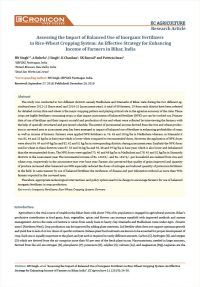Publications
- Potash fertilization for enhancing the productivity of pearlmillet-safflower sequence under dryland condition
- Large-scale demo plot trial project of potash fertilization for increased yield and profitability for smallholder soybean fields in India
- Response in Maize to Applied Potassium: Results from Field Demonstrations in the States of Andhra Pradesh, Chhattisgarh and Maharashtra
- Effect of Potash Fertilization on Potato Yields in States of West Bengal and Jammu & Kashmir
- Fertilizing Indian Rice Plots with Potash
- Assessing the Impact of Balanced Use of Inorganic Fertilizers in Rice-Wheat Cropping System in Bihar
- The Impact of Potassium Fertilization on Sugarcane Yields: A Comprehensive Experiment of Pairwise Demonstration Plots in Uttar Pradesh, India
- Benefits of Potash Fertilization in Rice in Six States of India – Results from Field Demonstrations
- Potash for Life – India, Since 2013
- Nutrition and Health – the Importance of Potassium (in Hindi)
- Potassium – a Nutrient Essential for Life (in Hindi)
- Potassium – the Quality Element in Crop Production (in Hindi)
- Deficiency Poster for Andhra Pradesh
- Tomato brochure for Maharashtra
- Sunflower brochure for Maharashtra
- Sugarcane brochure for Maharashtra
- Soyabean brochure for Maharashtra
- Sorghum brochure for Maharashtra
- Pomegranate brochure for Maharashtra
- Onion brochure for Maharashtra
- Maize brochure for Maharashtra
- Rice brochure for Karnataka
- Potash for Life infographic – results of the first season
- Potash for Life
- Balanced fertilization
- Potash for Life – first season summary
- Apple brochure
- Stone Fruit brochure
- Vegetables brochure
- Sunflower brochure
Assessing the Impact of Balanced Use of Inorganic Fertilizers in Rice-Wheat Cropping System in Bihar
The paper, “Assessing the Impact of Balanced Use of Inorganic Fertilizers in Rice-Wheat Cropping System: An Effective Strategy for Enhancing Income of Farmers in Bihar, India” was recently published in EC Agriculture journal. It summarises the impact assessment that was performed by Dr H.N. Singh from the Dept. of Agri Economics, GBPUAT, Pantnagar, India on the Potash for Life project in India in Bihar state.
Abstract:
The study was conducted in two different districts namely Madhubani and Sitamarhi of Bihar state during the two different agricultural year 2012-13 (base year) and 2014-15 (assessment year). A total of 58 farmers, 29 from each district have been selected for detailed survey. Rice and wheat is the major cropping pattern and playing critical role in the agrarian economy of the state. These crops are highly fertilizers consuming crops so that impact assessment of balanced fertilizer (NPK) use can be worked out. Primary data of use of fertilizer and their impact on yield and production of rice and wheat were collected by interviewing the farmers with the help of specially structured and pre-tested schedule. The extent of incremental income derived from the rice and wheat production in surveyed area in assessment year has been emerged as impact of balanced use of fertilizer in enhancing profitability of crops as well as income of farmers. Farmers were applied NPK fertilizers as 76, 45 and 28 kg/ha in Madhubani whereas, in Sitamarhi it was 82, 44 and 23 kg/ha in base year which is lower when compared to recommended doses. However, the application of NPK doses were about 84, 49 and 49 kg/ha and 82, 42 and 51 kg/ha in corresponding districts during assessment year. Similarly the NPK doses used in wheat in these districts were 87, 53 and 34 kg/ha and 93, 48 and 29 kg/ha in base year, which is also lower and imbalanced than the recommended doses. The NPK doses were applied 73, 40 and 48 kg/ha in Madhubani and 78, 43 and 52 kg/ha in Sitamarhi districts in the assessment year. The incremental income of Rs. 12633/- and Rs. 18174/- per household are realized from rice and wheat crop, respectively in the assessment year over base year. Farmer also perceived that quality of grain improved and quantity of produce increased after balanced use NPK especially reduced the doses of nitrogen and induced quantity of potassium fertilizers in the field. In same manner by use of balanced fertilizer, the incidences of disease and pest infestation reduced as more than 90% farmers reported in the surveyed area.
Therefore, appropriate technological interventions and policy option need to be design to encourage farmers for use of balanced inorganic fertilizers in crop production.





